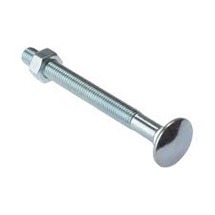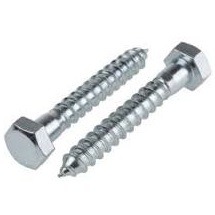Coach Bolts & Coach Screws: The Differences
One question we are often asked is what is the difference between a coach bolt and coach screw?
By comparing the images below you can see that the differences between coach bolts vs coach screws are clear – these fittings cannot be interchanged as they are used for completely different purposes.
| COACH BOLT | COACH SCREW |
 |
 |
Coach Bolt vs Coach Screw
Coach Bolts and Coach Screws are fixings that are primarily used in construction and timber trades. While both are mostly used for heavy timber applications, they differ in design and installation methods. Coach bolts require a nut for fastening, while coach screws are self-tapping and thread directly into wood.
What Is A Coach Bolt?
A coach bolt has a round head with a square underneath the head and it has a thread for a hexagon nut. You might see them being referred to as Carriage Bolts – this is because they were once used to fix metal straps to the wooden exterior of horse-drawn carriages!
Nowadays, coach bolts are most often used at critical points within a structure to join segments together. They are sturdy and robust and are far superior to nails and many other bolt types when used for joining timber to timber or timber to metal.
Coach bolts are available in a range of sizes. All coach bolts have metric coarse threads. They are most commonly used in the construction and timber trades.
Our Coach Bolts are available in multiple thread diameters (M5, M6, M8, M10, M12, M16, M20) and finishes (Bright Zinc Plated Steel, Self Colour Steel, Galvanised Steel, A2 Stainless Steel & A4 Stainless Steel), as well as ranging in length from 20mm to 300mm. Our Coach Bolts also come paired with matching Nuts for easy installation (except for our Stainless Steel Coach Bolts – nuts should be ordered separately for these).
What Is A Coach Screw?
Coach Screws, while similar, should not be confused with Coach Bolts. A coach screw has a hexagon head and a thread for screwing directly into wood. They’re essentially a heavy-duty screw for timber use.
Their primary use is generally to fasten heavy timber into position, for example when installing gates and fences.
You should always drill a pilot hole for a coach screw, otherwise, you run the risk of splitting the wood. The hole should be half the coach screw diameter for softwoods like pine or cedar, and three-quarters for hardwoods like oak and mahogany.
When fixing into timber we recommend using a flat washer or square plate washer to avoid unintentionally countersinking the head of the screw into the wood. For use with masonry, we recommend using a plastic plug to install your Coach Screws.
Our Coach Screws are available in multiple thread diameters (M6, M8, M10, M12, M16, M20) and finishes (Bright Zinc Plated Steel and A2 Stainless Steel). They range in length from 20mm to 200mm.
For a more in-depth exploration of these fasteners, including their applications and variations, click here to watch our video "An Introduction to Coach Bolts & Coach Screws".
If you have any questions that haven’t been answered in this article, please refer to our other guides and tips articles. You can also contact our team for help or advice – we’re always happy to assist you!



